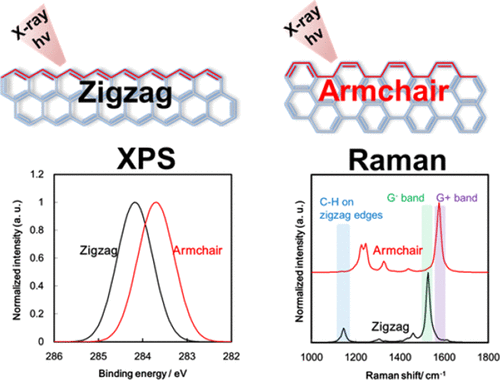Our official English website, www.x-mol.net, welcomes your
feedback! (Note: you will need to create a separate account there.)
Distinguishing Zigzag and Armchair Edges on Graphene Nanoribbons by X-ray Photoelectron and Raman Spectroscopies
ACS Omega ( IF 3.7 ) Pub Date : 2018-12-19 00:00:00 , DOI: 10.1021/acsomega.8b02744 Jungpil Kim 1 , Nodo Lee 1 , Young Hwan Min 1 , Seokhwan Noh 1 , Nam-Koo Kim 1 , Seokwon Jung 1 , Minho Joo 1 , Yasuhiro Yamada 2
ACS Omega ( IF 3.7 ) Pub Date : 2018-12-19 00:00:00 , DOI: 10.1021/acsomega.8b02744 Jungpil Kim 1 , Nodo Lee 1 , Young Hwan Min 1 , Seokhwan Noh 1 , Nam-Koo Kim 1 , Seokwon Jung 1 , Minho Joo 1 , Yasuhiro Yamada 2
Affiliation

|
Graphene nanoribbons (GNRs) have recently emerged as alternative 2D semiconductors owing to their fascinating electronic properties that include tunable band gaps and high charge-carrier mobilities. Identifying the atomic-scale edge structures of GNRs through structural investigations is very important to fully understand the electronic properties of these materials. Herein, we report an atomic-scale analysis of GNRs using simulated X-ray photoelectron spectroscopy (XPS) and Raman spectroscopy. Tetracene with zigzag edges and chrysene with armchair edges were selected as initial model structures, and their XPS and Raman spectra were analyzed. Structurally expanded nanoribbons based on tetracene and chrysene, in which zigzag and armchair edges were combined in various ratios, were then simulated. The edge structures of chain-shaped nanoribbons composed only of either zigzag edges or armchair edges were distinguishable by XPS and Raman spectroscopy, depending on the edge type. It was also possible to distinguish planar nanoribbons consisting of both zigzag and armchair edges with zigzag/armchair ratios of 4:1 or 1:4, indicating that it is possible to analyze normally synthesized GNRs because their zigzag to armchair edge ratios are usually greater than 4 or less than 0.25. Our study on the precise identification of GNR edge structures by XPS and Raman spectroscopy provides the groundwork for the analysis of GNRs.
中文翻译:

用X射线光电子能谱和拉曼光谱学区分石墨烯纳米带上的锯齿形和扶手椅形边缘
石墨烯纳米带(GNR)由于其引人入胜的电子性能(包括可调带隙和高载流子迁移率)而成为替代2D半导体。通过结构研究确定GNR的原子尺度边缘结构对于充分了解这些材料的电子特性非常重要。在这里,我们报告使用模拟X射线光电子能谱(XPS)和拉曼光谱对GNR进行原子级分析。选择具有锯齿形边缘的四氢呋喃和具有扶手椅形边缘的石墨作为初始模型结构,并对它们的XPS和拉曼光谱进行分析。然后,模拟了基于并四苯和并苯的锯齿状和扶手椅状边缘以不同比例结合的结构扩展的纳米带。根据边缘类型,通过XPS和拉曼光谱可以区分仅由锯齿形边缘或扶手椅形边缘组成的链状纳米带的边缘结构。还可以区分曲折/扶手椅比为4:1或1:4的由曲折和扶手椅边缘组成的平面纳米带,这表明可以分析通常合成的GNR,因为它们的曲折与扶手椅边缘比通常大于4或小于0.25。我们对通过XPS和拉曼光谱精确识别GNR边缘结构的研究为分析GNR提供了基础。还可以区分曲折/扶手椅比为4:1或1:4的由曲折和扶手椅边缘组成的平面纳米带,这表明可以分析通常合成的GNR,因为它们的曲折与扶手椅边缘比通常大于4或小于0.25。我们对通过XPS和拉曼光谱法精确识别GNR边缘结构的研究为分析GNRs提供了基础。还可以区分曲折/扶手椅比为4:1或1:4的由曲折和扶手椅边缘组成的平面纳米带,这表明可以分析通常合成的GNR,因为它们的曲折与扶手椅边缘比通常大于4或小于0.25。我们对通过XPS和拉曼光谱法精确识别GNR边缘结构的研究为分析GNRs提供了基础。
更新日期:2018-12-19
中文翻译:

用X射线光电子能谱和拉曼光谱学区分石墨烯纳米带上的锯齿形和扶手椅形边缘
石墨烯纳米带(GNR)由于其引人入胜的电子性能(包括可调带隙和高载流子迁移率)而成为替代2D半导体。通过结构研究确定GNR的原子尺度边缘结构对于充分了解这些材料的电子特性非常重要。在这里,我们报告使用模拟X射线光电子能谱(XPS)和拉曼光谱对GNR进行原子级分析。选择具有锯齿形边缘的四氢呋喃和具有扶手椅形边缘的石墨作为初始模型结构,并对它们的XPS和拉曼光谱进行分析。然后,模拟了基于并四苯和并苯的锯齿状和扶手椅状边缘以不同比例结合的结构扩展的纳米带。根据边缘类型,通过XPS和拉曼光谱可以区分仅由锯齿形边缘或扶手椅形边缘组成的链状纳米带的边缘结构。还可以区分曲折/扶手椅比为4:1或1:4的由曲折和扶手椅边缘组成的平面纳米带,这表明可以分析通常合成的GNR,因为它们的曲折与扶手椅边缘比通常大于4或小于0.25。我们对通过XPS和拉曼光谱精确识别GNR边缘结构的研究为分析GNR提供了基础。还可以区分曲折/扶手椅比为4:1或1:4的由曲折和扶手椅边缘组成的平面纳米带,这表明可以分析通常合成的GNR,因为它们的曲折与扶手椅边缘比通常大于4或小于0.25。我们对通过XPS和拉曼光谱法精确识别GNR边缘结构的研究为分析GNRs提供了基础。还可以区分曲折/扶手椅比为4:1或1:4的由曲折和扶手椅边缘组成的平面纳米带,这表明可以分析通常合成的GNR,因为它们的曲折与扶手椅边缘比通常大于4或小于0.25。我们对通过XPS和拉曼光谱法精确识别GNR边缘结构的研究为分析GNRs提供了基础。


















































 京公网安备 11010802027423号
京公网安备 11010802027423号